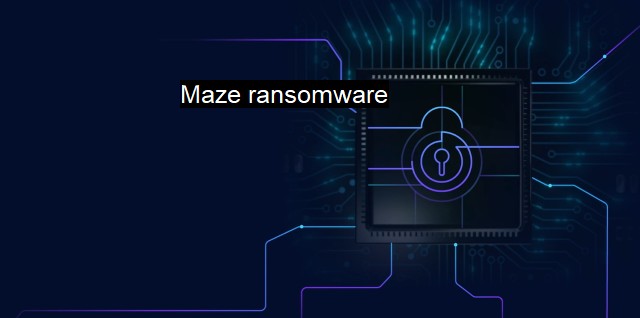What is Maze ransomware?
Unleashing Chaos: The Menace of Maze Ransomware and Why It Poses a Serious Threat to Cybersecurity
Maze ransomware represents a particular type of malicious software that is known for its unique attributes and damaging results. Like many other strains of ransomware, once Maze infiltrates a system, it proceeds to encrypt data, lock down files, and then demand ransom into cryptocurrency for restoration services.The Maze ransomware, unlike it’s predecessors, integrates an extra layer of damage by 'shaming' its victims into paying ransoms. This is typically done by first publicly releasing a fraction amount of the company's stolen data to the dark web as a 'proof' of attack before later leaking the remainder if the ransom is not met. This secondary intimidation tactic undermines a company not just financially (through the cost of dealing with a cybersecurity incident and likely effect on insurance premiums), but also damages its reputation, potentially eroding customer trust and future business prospects.
Maze ransomware operators often leverage well-known attack vectors, including phishing email campaigns aimed at tricking unsuspecting users into downloading the malware. Recently the attackers have begun utilizing exploit kits and malicious downloadable software to infiltrate vulnerable networks and are also often seen exploiting well-known software vulnerabilities as the initial entry point for their criminal choreography.
One of the insightful incidents of a Maze attack happened with IT Services giant "Cognizant Technology Solutions". Their networks were infected by Maze that posed massive business interruption and conflicts that marked millions in expenses and revenue loss. With approximately 300,000 employees worldwide, needless to say, the ripple effect of this single attack was extensive and costly.
When Maze ransomware first attacks a system, it scans for files and alters the original files through AES encryption and appends a random extension onto each encrypted file. To extract the maximum ransom, it smartly encrypts files that are most likely to cause immediate disruptions, such as Microsoft Word, Excel or important databases rather than large multimedia files that would slow the website's operation down, sabotaging the company to cope using manual methods or backups.
Dealing with the aftermath of a Maze ransomware involves multiple steps such as removing the infected systems from the network, identifying the ransom note, analyzing the ransomware sample, and restoring files. The encryption algorithms used by the attackers are often dauntingly complex, leading victims with little recourse beyond seeking professional cybersecurity support and in many cases, paying the demanded ransom.
It is very important to note here is that even though the attackers promise to provide keys upon ransom payment, there is no assurance that victims will have their data restored. It's strictly suggested by cybersecurity professionals not to pay these cyber bandits since it encourages them to propagate this crime further.
To decrease susceptibility to such sophisticated Maze attacks and improve resilience, it is important to adopt multi-point, fortified cybersecurity strategies. Infrastructure hygiene measures, such as regular patch updates, employee cyber awareness training, multilayered email defence system can dramatically reduce the attack surface. Further-more after the data encryption, immediate shut down may prevent valuable data leakage over the network. Businesses are also urged to take robust backup solutions seriously to restore the system if a breach occurs.
Organizations can doe comprehensive cybersecurity audits including vulnerability assessments and penetration testing to identify possible weak points that can be reinforced. Investing in strongly adhered security policies, protocols and having a pre-modeled incident response pan can limit the damage and rescue in a timely manner.
Maze ransomware leverage on both fear and shame, setting a menacing precedent within the global cyber threat landscape. Developing a layered, dynamic cybersecurity strategy is paramount to combat such threats. Despite constant arms race between cybercriminals and cybersecurity professionals, emerging threat intelligence, machine learning-based solutions, cross-industry collaboration and international law enforcement cooperation are the modern shields that can together, thwart such sinister extortion schemes.

Maze ransomware FAQs
What is Maze ransomware?
Maze ransomware is a type of malware that encrypts files on a victim's computer and demands a ransom payment in exchange for the decryption key. It is known for its advanced techniques and has caused significant damage to businesses and organizations around the world.How does Maze ransomware infect a computer?
Maze ransomware typically infects a computer through social engineering techniques such as phishing emails or malicious attachments. Once it gains access to a computer, it spreads quickly throughout the network and starts encrypting files.What should I do if my computer is infected with Maze ransomware?
If your computer is infected with Maze ransomware, it is important to disconnect it from the network immediately to prevent the malware from spreading to other devices. You should also contact a cybersecurity professional as soon as possible to assist with removal and recovery of your files.Can antivirus software prevent Maze ransomware attacks?
Antivirus software can help prevent Maze ransomware attacks by detecting and blocking malicious files and websites, as well as identifying suspicious behavior. However, because Maze ransomware uses advanced techniques, it is important to stay abreast of the latest cybersecurity threats and take additional measures to protect your systems and data.| | A | | | B | | | C | | | D | | | E | | | F | | | G | | | H | | | I | | | J | | | K | | | L | | | M | |
| | N | | | O | | | P | | | Q | | | R | | | S | | | T | | | U | | | V | | | W | | | X | | | Y | | | Z | |
| | 1 | | | 2 | | | 3 | | | 4 | | | 7 | | | 8 | | |||||||